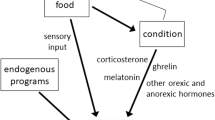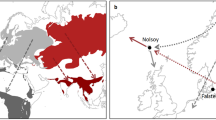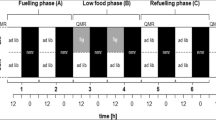Abstract
To support migratory endurance flight, birds accumulate large amounts of fat by hyperphagia (fueling). Whereas the factors influencing migrants’ motivation to fuel are well described, the physiological mechanism regulating fueling is largely unknown. Hormones are likely involved and arguably the best studied with respect to food intake and fueling is corticosterone. Corticosterone has a permissive effect, as blocking the hormone’s actions prohibits efficient fueling. There are no indications, though that corticosterone stimulates fueling, and some studies even observed negative correlations between corticosterone level and food intake and speed of fueling. The latter is unexpected as slow fueling could reduce the overall speed of migration. To test the causality of these negative correlations, I non-invasively increased circulating corticosterone levels in captive migrants and determined its effect on food intake and fuel accumulation. Neither food intake nor fuel accumulation differed between corticosterone-treated and control-treated individuals. This indicates that corticosterone does not hamper food intake and fueling during stopovers, nor does it stimulate these processes. Promising alternative candidates for the regulation of migratory hyperphagia are ‘appetite regulating’ hormones secreted by the adipose tissue, gut, or gastro-intestinal tract. The advance of next-generation sequencing will facilitate a bottom-up approach when investigating these.


Similar content being viewed by others
References
Bauchinger U, Van’t Hof T, Biebach H (2008) Migratory stopover conditions affect the developmental state of male gonads in garden warblers (Sylvia borin). Horm Behav 54:312–318
Bayly NJ (2006) Optimality in avian migratory fuelling behavior: a study of a trans-Saharan migrant. Anim Behav 71:173–182
Bayly NJ (2007) Extreme fattening by sedge warblers, Acrocephalus schoenobaenus, is not triggered by food availability alone. Anim Behav 74:471–479
Berthold P, Fiedler W, Querner U (2000) Migratory restlessness or Zugunruhe in birds—a description based on video recordings under infrared illumination. J Ornithol 141:285–299
Biebach H (1985) Sahara stopover in migratory flycatchers: fat and food affect the time program. Experientia 41:695–697
Boswell T, Dunn IC (2015) Regulation of the avian central melanocortin system and the role of leptin. Gen Comp Endocrinol 221:278–283
Breuner CW, Greenberg AL, Wingfield JC (1998) Noninvasive corticosterone treatment rapidly increases activity in Gambel’s white-crowned sparrows (Zonotrichia leucophrys gambelii). Gen Comp Endocrin 111:386–394
Chernetsov N (2012) Passerine migration: stopovers and flight. Springer, Berlin
Conway-Campbell BL, Pooley JR, Hager GL, Lightman SL (2012) Molecular dynamics of ultradian glucocorticoid receptor action. Mol Cell Endocrinol 348:383–393
Corman AM, Bairlein F, Schmaljohann H (2014) The nature of the migration route shapes physiological traits and aerodynamic properties in a migratory songbird. Behav Ecol Sociobiol 68:391–402
Cornelius JM, Boswell T, Jenni-Eiermann S, Breuner CW, Ramenofsky M (2013) Contributions of endocrinology to the migration life history of birds. Gen Comp Endocrinol 190:47–60
Dakin CL, Small CJ, Batterham RL, Neary NM, Cohen MA, Patterson M, Ghatei MA, Bloom SR (2004) Peripheral oxyntomodulin reduces food intake and body weight gains in rats. Endocrinology 145:687–2695
Delingat J, Dierschke V, Schmaljohann H, Mendel B, Bairlein F (2006) Daily stopovers as optimal migration strategy in a long-distance migrating passerine: the northern wheatear Oenanthe oenanthe. Ardea 94:593–605
Denbow DM (1989) Centrally and peripherally administered bombesin decreases food intake in turkeys. Peptide 10:275–279
Dickmeis T, Weger BD, Weger M (2013) The circadian clock and glucocorticoids—Interactions across many time scales. Mol Cell Endocrinol 380:2–15
Eikenaar C, Schläfke JL (2013) Size and accumulation of fuel reserves at stopover predict nocturnal restlessness in a migratory bird. Biol Lett 9:20130712
Eikenaar C, Fritzsch A, Bairlein F (2013) Corticosterone and migratory fueling in northern wheatears facing different barrier crossings. Gen Comp Endocrin 186:181–186
Eikenaar C, Klinner T, Szostek KL, Bairlein F (2014a) Migratory restlessness in captive individuals predicts actual departure in the wild. Biol Lett 10:20140154
Eikenaar C, Bairlein F, Stöwe M, Jenni-Eiermann S (2014b) Corticosterone, food intake and refueling in a long-distance migrant. Horm Behav 65:480–487
Eikenaar C, Klinner T, Stöwe M (2014c) Corticosterone predicts nocturnal restlessness in a long-distance migrant. Horm Behav 66:324–329
Eikenaar C, Tsvey A, Schmaljohann H (2015) Faster spring migration in northern wheatears is not explained by an endogenous seasonal difference in refueling rates. J Avian Biol 46:616–621
Forlenza GP, Calhoun A, Beckman KB, Halvorsen T, Hamdoun E, Zierhut H, Sarafoglou K, Plogreen LE, Miller, BS, Nathan B, Petryk A (2015) Next generation sequencing in endocrine practice. Mol Genet Metab 115:61–71
Fransson T (1998) Patterns of migratory fueling in whitethroats Sylvia communis in relation to departure. J Avian Biol 29:569–573
Friedman JM, Halaas JM (1998) Leptin and the regulation of body weight in mammals. Nature 395:763–770
Fusani L, Coccon F, Rojas Mora A, Goymann W (2013) Melatonin reduces migratory restlessness in Sylvia warblers during autumnal migration. Front Zool 10:79
Gibbs J, Fauser DJ, Rowe EA, Rolls BJ, Rolls ET, Maddison SP (1979) Bombesin suppresses feeding in rats. Nature 282:208–210
Gwinner E, Schwabl H, Schwabl-Benzinger I (1988) Effects of food-deprivation on migratory restlessness and diurnal activity in the garden warbler. Oecologia 77:321–326
Hameed S, Dhillo WS, Bloom SR (2009) Gut hormones and appetite control. Oral Dis 15:18–26
Holberton RL, Wilson CM, Hunter MJ, Cash WB, Sims CG (2007) The role of corticosterone in supporting migratory lipogenesis in the dark-eyed junco, Junco hyemalis: a model for central and peripheral regulation. Phys Biochem Zool 80:125–137
Hume ID, Biebach H (1996) Digestive tract function in the long-distance migratory garden warbler, Sylvia borin. J Comp Physiol B 166:388–395
Jenni L, Jenni-Eiermann S (1998) Fuel supply and metabolic constraints in migrating birds. J Avian Biol 29:521–528
Jenni L, Schaub M (2003) Behavioural and physiological reactions to environmental variation in bird migration: a review. In: Berthold P, Gwinner E, Sonnenschein E (eds) Avian migration. Springer, Berlin, Heidelberg, pp 155–171
Kaiya H, Kangawa K, Miyazato M (2013) What is the general action for ghrelin in vertebrates?—Comparisons of ghrelin’s effects across vertebrates. Gen Comp Endocrinol 181:187–191
Kraus RHS, Wink M (2015) Avian genomics: fledging into the wild! J Ornithol 156:851–865
Landys MM, Ramenofsky M, Guglielmo CG, Wingfield JC (2004) The low-affinity glucocorticoid receptor regulates feeding and lipid breakdown in the migratory Gambel’s white-crowned sparrow Zonotrichia leucophrys gambelii. J Exp Biol 207:143–154
Landys MM, Ramenofsky M, Wingfield JC (2006) Actions of glucocorticoids at a seasonal baseline as compared to stress-related levels in the regulation of periodic life processes. Gen Comp Endocrinol 148:132–149
Landys-Cianelli MM, Ramenofsky M, Piersma T, Jukema J, Castricum Ringing Group, Wingfield JC (2002) Baseline and stress-induced plasma corticosterone during long-distance migration in the bar-tailed godwit, Limosa lapponica. Phys Biochem Zool 75:101–110
Lerner HRL, Fleischer RC (2010) Prospects for the use of next generation sequencing methods in ornithology. Auk 127:4–15
Lõhmus M, Sandberg R, Holberton RL, Moore FR (2003) Corticosterone levels in relation to migratory readiness in red-eyed vireos (Vireo olivaceus). Behav Ecol Sociobiol 54:233–239
Lõhmus M, Sundström LF, Moore FR (2006) Non-invasive corticosterone treatment changes foraging intensity in red-eyed vireos. J Avian Biol 37:523–526
Owen JC, Garvin MC, Moore FR (2014) Elevated testosterone advances onset of migratory restlessness in a nearctic-neotropical landbird. Behav Ecol Sociobiol 68:561–569
Ramenofsky M (2011) Hormones in migration and reproductive cycles of birds. In: Norris DO, Lopez KH (eds) Hormones and reproduction of vertebrates. Academic Press, London, pp 181–204
Rasbash J, Steele F, Browne WJ, Goldstein H (2012) A user’s guide to MLwiN, version 2.26
Richardson RD, Boswell T, Weatherford SC, Wingfield JC, Woods SC (1993) Cholecystokinin octapeptide decreases food intake in white-crowned sparrows. Am J Physiol 264:R852–R856
Rodriguez-Sinovas A, Fernandez E, Manteca X, Fernandez G, Gonalons E (1997) CCK is involved in both peripheral and central mechanisms controlling food intake in chickens. Am J Physiol 272:R334–R340
Savory CJ (1987) An alternative explanation for apparent satiating properties of peripherally administered bombesin and cholecystokenin in domestic fowls. Physiol Behav 39:191–202
Schaub M, Jenni L, Bairlein F (2008) Fuel stores, fuel accumulation, and the decision to depart from a migration stopover site. Behav Ecol 19:657–666
Schmaljohann H, Naef-Daenzer B (2011) Body condition and wind support initiate the shift of migratory direction and timing of nocturnal departure in a songbird. J Anim Ecol 80:1115–1122
Shousha S, Nakahara K, Nasu T, Sakamoto T, Murakami N (2007) Effect of glucagon-like peptide-1 and -2 on regulation of food intake, body temperature and locomotor activity in the Japanese quail. Neurosci Lett 415:102–107
Stanley S, Wynne K, McGowan B, Bloom S (2005) Hormonal regulation of food intake. Physiol Rev 85:1131–1158
Stuber EF, Verpeut J, Horvat-Gordon M, Ramachandran R, Bartell PA (2013) Differential regulation of adipokines may influence migratory behavior in the white-throated sparrow (Zonotrichia albicollis). PLos One. doi:10.1371/journal.pone.0059097
Tang-Christensen M, Vrang N, Larsen PJ (2001) Glucagon-like peptide containing pathways in the regulation of feeding behaviour. Int J Obes Relat Metab Disord 25:S42–S47
Tonra CM, Marra PP, Holberton RL (2011) Early elevation of testosterone advances migratory preparation in a songbird. J Exp Biol 214:2761–2767
Wingfield JC, Schwabl H, Mattock PW Jr (1990) Endocrine mechanisms of migration. In: Gwinner E (ed) Bird migration. Springer, Berlin, pp 232–256
Wynne K, Stanley S, McGowan B, Bloom S (2005) Appetite control. J Endocrinol 184:291–318
Acknowledgements
I thank guest editors Franz Bairlein and Wolfgang Wiltschko for the invitation to write this paper, and Sven Hessler for help with the experiment. Three reviewers provided useful comments.
Author information
Authors and Affiliations
Corresponding author
Ethics declarations
Ethical approval
All applicable international, national, and/or institutional guidelines for the care and use of animals were followed.
Rights and permissions
About this article
Cite this article
Eikenaar, C. Endocrine regulation of fueling by hyperphagia in migratory birds. J Comp Physiol A 203, 439–445 (2017). https://doi.org/10.1007/s00359-017-1152-1
Received:
Revised:
Accepted:
Published:
Issue Date:
DOI: https://doi.org/10.1007/s00359-017-1152-1




